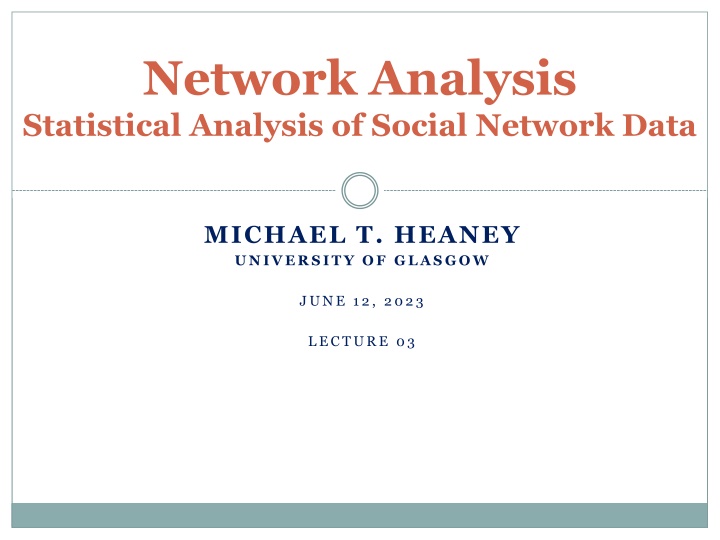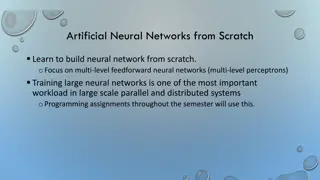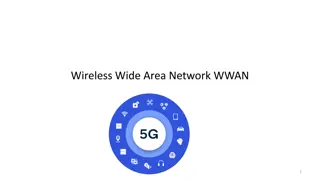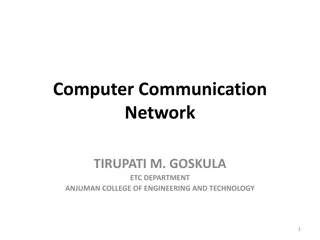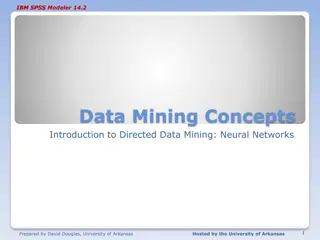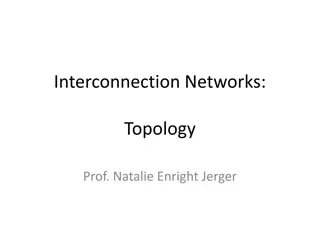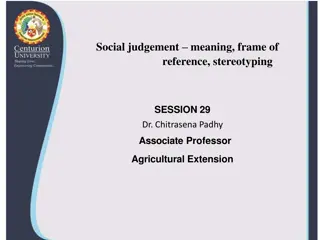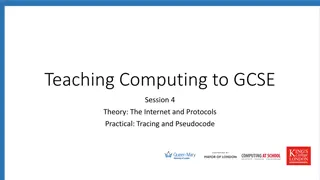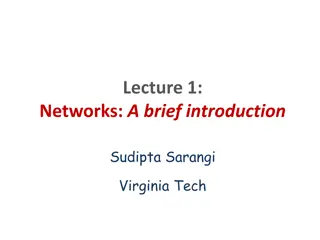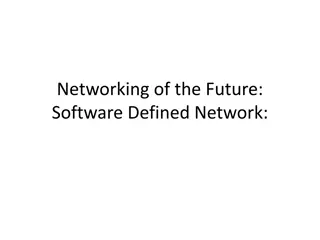Network Analysis: Whole Networks vs. Ego Networks
Explore the differences between Whole Networks and Ego Networks in social network analysis. Whole Networks provide comprehensive information about all nodes and links, enabling the computation of network-level statistics. On the other hand, Ego Networks focus on a sample of nodes, limiting the ability to compute network-level statistics. The distinction lies in the data collection process rather than inherent differences in the networks themselves. Whole Networks are often studied in elites, institutions, and computer networks, while Ego Networks are common in analyzing individual behavior. Different analysis techniques are applied to each type of network, emphasizing the importance of understanding their unique characteristics in social network analysis.
Download Presentation

Please find below an Image/Link to download the presentation.
The content on the website is provided AS IS for your information and personal use only. It may not be sold, licensed, or shared on other websites without obtaining consent from the author.If you encounter any issues during the download, it is possible that the publisher has removed the file from their server.
You are allowed to download the files provided on this website for personal or commercial use, subject to the condition that they are used lawfully. All files are the property of their respective owners.
The content on the website is provided AS IS for your information and personal use only. It may not be sold, licensed, or shared on other websites without obtaining consent from the author.
E N D
Presentation Transcript
Network Analysis Statistical Analysis of Social Network Data MICHAEL T. HEANEY UNIVERSITY OF GLASGOW JUNE 12, 2023 LECTURE 03
Research Design and Data Whole Networks vs. Ego Networks Boundary Specification Questionnaire Design Data Formats
Whole Networks vs. Ego Networks Whole networks observer has information about all nodes and links in the network all network-level statistics can be computed
Whole Networks vs. Ego Networks Whole networks observer has information about all nodes and links in the network all network-level statistics can be computed Ego Networks observer only has information about the links to a sample of the nodes network- level statistics cannot be computed e.g., we know about the properties of the first-degree contacts, such as sex, age, etc.
Whole Networks vs. Ego Networks Whole networks observer has information about all nodes and links in the network all network-level statistics can be computed Ego Networks observer only has information about the links to a sample of the nodes network-level statistics cannot be computed e.g., we know about the properties of the first-degree contacts, such as sex, age, etc. It is not the networks themselves that differ, but our ability to collect information about them.
Whole Networks vs. Ego Networks Whole networks most common in the study of elites and institutions, as well as computer networks. Ego Networks most common in the study of individual behavior
Whole Networks vs. Ego Networks Whole networks all network analysis techniques can be used Ego Networks analysis techniques involve analysis of the alters of focal persons
Snowball Sampling Snowball sampling creates an intermediate network that is somewhere between an ego network and a whole network. Procedure: 1. Select a random sample from the population 2. Ask each respondent in the random sample about network alters. 3. Contact those alters and request information on those alters. 4. Contact the alters of the alters. 5. Continue .
Problems with Snowball Sampling Snowball sampling selects a sample on the basis of the network structure. As a result, snowball sampling yields networks that appear to be more closely connected and cliquey than they really are. Snowball sampling inherently has huge selection bias problems
Legitimate Uses of Snowball Sampling Snowball sampling may be useful if the statistical models account for the snowballing in the estimation process (i.e., respondent-driven sampling) This method may be especially effective in studying small populations when the snowballing exhausts the total population (i.e., there is no selection bias if the entire population is selected). May work for political elites, IV-drug users. Douglas D. Heckathorn, "Respondent-Driven Sampling: A New Approach to the Study of Hidden Populations," Social Problems (1997).
Boundary Specification Edward O. Laumann et al, The Boundary Specification Problem in Network Analysis. In Research Methods in Social Network Analysis (1989). Networks do not have natural boundaries. Networks are constructed by the researcher with a research purpose in mind. Best practice is to use multiple, objective data sources to identify nodes for analysis.
Take Out a Sheet of Paper (not turned in) Write down the names of your closest friends. Write down the names of people who you talk to about politics. Write down the names of the people you drink beer with. Write down the names of the people you have been on a date with in the last year. (Use initials if you like.)
Goals for Measuring the Network Whole Network attempting to look at how every actor is connected with every other small social systems Ego Network attempting to look only at part of the network perhaps, what are the kinds of people you are connected with (e.g., how many of your friends are men, women) large social system
Two Basic Question Formats Fixed List (analogous to closed-ended questions) Name generator (analogous to open-ended questions)
Name Generator See Merrill Lynch survey.
Fixed list: Advantages / Disadvantages Advantages -- People are less likely to forget social ties -- Clearly defined network boundaries -- Works well when the social system is small or when analyzing elites -- Usually the approach when measuring whole network (but not always)
Fixed list: Advantages / Disadvantages Disadvantages -- Important network contacts may not be on the list -- Difficult and time-consuming to go through entire list (fatigue effects) -- Real network may be ill defined -- Must have the whole list works only in small networks or elite networks
Name Generator: Advantages / Disadvantages Advantages -- Flexibility: people can name anyone they like -- Efficiency: it is easy to ask for a large amount of information in a small space -- Efficacy: Accommodates large social networks -- Usually the approach when measuring ego networks (but not always)
Name Generator: Advantages / Disadvantages Disadvantages -- Forgetting is a major problem -- Variance from person to person in threshold for listing -- Measuring network degree may be highly unreliable
Tricks for Name Generators Constrain the number of alters list (e.g., name your top three best friends) highly problematic because it artificially constrains network degree Multiple asking of the same (or similar) question Allow respondents to revise their answers. Prompt people with something concrete (e.g., who do you meet for coffee rather than who are your friends)
Types of Questions Existence of Ties (e.g., Who are your friends?) Frequency of ties (e.g., How often do you meet?) Evaluation of ties (e.g., Who is your best friend? Who is most influential?) Types of ties (e.g., What types of people are you tied to? Are your friends old, young, poli sci majors?)
Data Formats Adjacency Matrix / Spreadsheet -- GOOD FOR SMALL NETWORKS A B C D A 1 0 1 0 B 0 1 0 1 C 1 0 1 0 D 0 1 0 1 Edgelist GOOD FOR LARGE NETWORKS AC BD EF An adjacency matrix can be converted to an edgelist, and vice versa
Ethical Considerations Some network data may not be easily anonymized Is it legitimate to use network data for commercial purposes?
